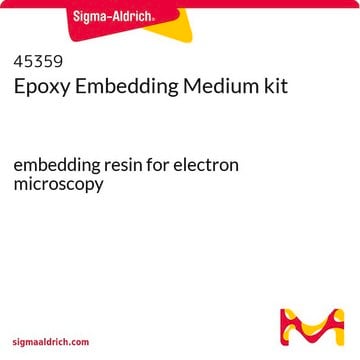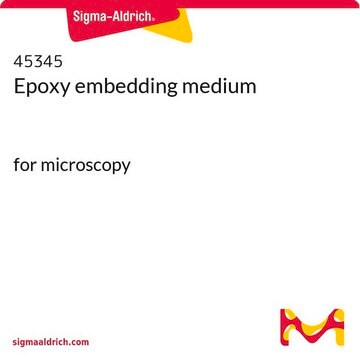75633
Osmium tetroxide solution
suitable for electron microscopy, 2% in H2O
Synonyme(s) :
Osmium(IV) oxide
About This Item
Produits recommandés
Forme
solution
Pertinence de la réaction
reagent type: oxidant
Concentration
2% in H2O
Technique(s)
electron microscopy: suitable
Couleur
colorless to yellow
Densité
1.0 g/mL at 20 °C
1.0 g/mL at 20 °C
Application(s)
hematology
histology
Température de stockage
2-8°C
Chaîne SMILES
O=[Os](=O)(=O)=O
InChI
1S/4O.Os
Clé InChI
VUVGYHUDAICLFK-UHFFFAOYSA-N
Vous recherchez des produits similaires ? Visite Guide de comparaison des produits
Description générale
Application
Actions biochimiques/physiologiques
Mention d'avertissement
Danger
Mentions de danger
Classification des risques
Acute Tox. 2 Dermal - Acute Tox. 4 Inhalation - Acute Tox. 4 Oral - Eye Dam. 1 - Skin Irrit. 2
Code de la classe de stockage
6.1B - Non-combustible acute toxic Cat. 1 and 2 / very toxic hazardous materials
Classe de danger pour l'eau (WGK)
WGK 1
Point d'éclair (°F)
Not applicable
Point d'éclair (°C)
Not applicable
Équipement de protection individuelle
Faceshields, Gloves, Goggles, type ABEK (EN14387) respirator filter
Certificats d'analyse (COA)
Recherchez un Certificats d'analyse (COA) en saisissant le numéro de lot du produit. Les numéros de lot figurent sur l'étiquette du produit après les mots "Lot" ou "Batch".
Déjà en possession de ce produit ?
Retrouvez la documentation relative aux produits que vous avez récemment achetés dans la Bibliothèque de documents.
Les clients ont également consulté
Notre équipe de scientifiques dispose d'une expérience dans tous les secteurs de la recherche, notamment en sciences de la vie, science des matériaux, synthèse chimique, chromatographie, analyse et dans de nombreux autres domaines..
Contacter notre Service technique






